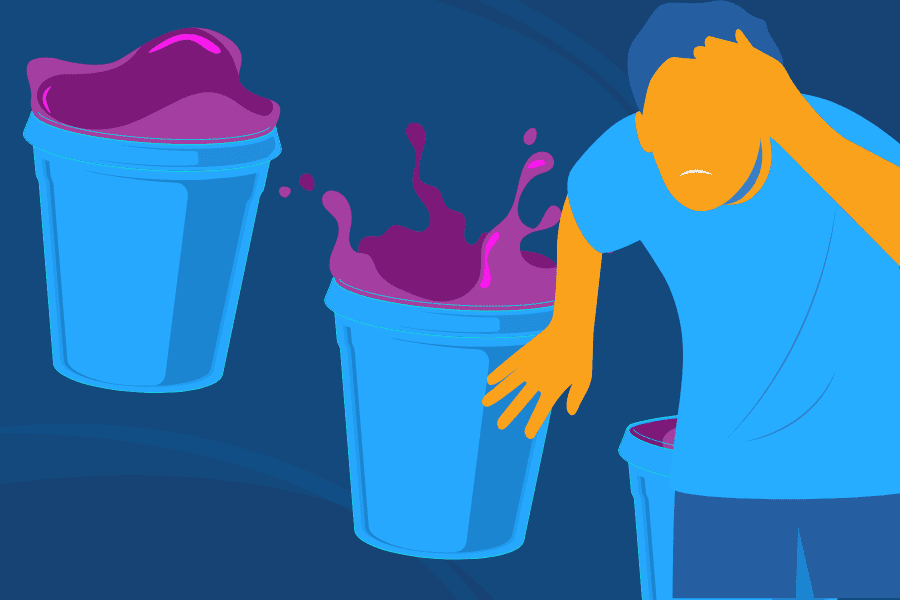Adolescence is a pivotal time when some of the most important development of social and intellectual skills takes place. It is when children pull away from their parents and turn to peers for advice and support.
As the parent of a teen, it is not always easy to separate the harmless things from danger when it comes to adolescent behavior. Understanding the connection between drug abuse and troubled teens may help you safely guide your teenager through this stage of life.
Drug Abuse & Troubled Teens Statistics
The teenage years were once considered a time of experimentation, and the connection between teens and alcohol or marijuana use was often written off as a harmless phase, something they would outgrow.
Statistics, however, show that while this may be true for many teens, there is still a significant percentage for whom this is a dangerous perspective. Many of the 23.5 million Americans suffering from addiction began their substance use during their teenage years.
In fact, approximately 90% of Americans who suffer from addiction began using drugs before they were 18 years old.
People who use addictive substances when they are teenagers are more likely to become dependent on the substance than their people who begin using those same addictive substances when they are over 20 years old.
Almost 50% of high school students use addictive substances including alcohol, drugs or tobacco. This data is according to the National Center on Addiction and Substance Abuse.
In addition, about 75% of high school students in the United States have used an addictive substance at least once.
These rates of substance abuse and addiction are troubling. They call for additional education for teens and parents about the line between experimentation and use that will eventually become highly problematic.
It is important for parents and teens to understand the value of early intervention in avoiding life-long struggles with substances.
Addiction & Adolescence
While they may look like adults, teenagers are still very much in their developmental years. Their brains are continuing to develop well into their mid-twenties, which makes them more vulnerable to certain dangers.
Teenagers tend to engage in riskier behaviors than other age groups. This is a result of limited life experience and also because of the fact that teens tend to overestimate the potential gain of taking risks.
Contrary to popular belief, teens are not unaware of consequences, they are just wired to prioritize reward over consequence.
Teens are also wired to seek novelty which is an adaptive quality as they move toward greater independence, but one which can make them more disposed towards trying addictive substances.
Teenagers are also easily influenced by their peers. It is important to understand both the positive and negative potential of this tendency, which is addressed in more depth in this post.
While parents may tear their hair out at risky “groupthink” decisions made by their kids, or worry that they are hanging out with “troubled teens,” it is actually an important part of development for teens to turn towards peers and not just rely on their family of origin.
The ability to create a strong social support network among peers is one of the most important predictors of adult success and happiness.
The challenge for parents then is to honor that this is an important part of their child’s development, while also setting limits and providing support to their kids in identifying a peer group that will support rather than endanger them.
In the midst of all this peer bonding, adolescents are also developing their own identities. Their bodies are maturing, adding to their angst about who they are and how they want to be perceived.
They do things to stand out in the crowd or to try to appear more adult than they are and they test their boundaries.
How Childhood Trauma Can Contribute to Drug Abuse
There is a strong correlation between childhood trauma and drug abuse later in life.
The effects of childhood trauma on drug abuse were documented in the Adverse Childhood Experiences (ACE) study which measured childhood traumas in doses, or ACEs.
These adverse experiences included not only what we would commonly consider “trauma” such as abuse and neglect, but also difficult and more common life experiences such as parental divorce, living with a substance abuser, or the death of a parent.
The study found that the more categories of adverse experiences a person was exposed to, the higher the risk for a host of problems, including illness, incarceration, and substance abuse.
The study’s findings are alarming: for example, boys who had four or more ACEs had a 46 times increased risk in becoming an IV drug user.
We know that trauma is not something that impacts only certain communities such as lower-income families or minorities – in fact, trauma affects people of all racial and socioeconomic backgrounds.
While all the mechanisms of how early childhood trauma contributes to problems such as substance abuse are not fully understood, we do know that repeated trauma can actually change the brain and set people on a constant state of high-alert.
This is very taxing to the body and the nervous system. Ultimately, it decreases a child’s ability to emotionally regulate and to appropriately assess threats.
Substance use can be very appealing for a person who has trouble regulating themselves, as most substances act on the central nervous system. Being a teen already involves lots of novel experiences, new challenges, and difficult social situations.
For a teen who has experienced trauma and is already on high alert, this can be particularly overwhelming, and the promise of a substance that calms them, that tamps down their central nervous system, or that allows them greater focus can be very appealing.
Of course, while this may provide teens with a temporary solution, in the long-term substance abuse negatively impacts a teen’s ability to reason, regulate emotion, and often exposes them to dangerous situations which further the trauma.
When drugs are used as a coping mechanism for childhood trauma, the drug abuse will be difficult to overcome until the trauma is appropriately addressed.
How Drugs Change Your Teen
No matter what your age, drugs alter the chemical balance in your brain. This is how the high is produced. The drug interferes with the chemical communication system in the pleasure centers of your brain.
Some drugs mimic natural substances found in your brain, flooding your brain with feel-good chemicals while other drugs block your brain’s receptors for certain types of chemicals.
The flood of chemicals can severely disturb the delicate balance of the brain. Your brain adjusts to the influx by producing fewer feel-good chemicals on its own and pruning the receptors that absorb these chemicals.
With extended use, the drug can cripple your brain’s ability to experience pleasure on its own. This also causes the phenomenon of increased tolerance, wherein more of a drug is required to experience the same high.
While all of this brain chemical activity is going on inside, there are some noticeable changes happening on the outside as well. Drug abuse begins to change your child’s behavior and personality.
It is typically a secret activity, so a child who was fun and outgoing tends to become more withdrawn and isolated. They may even withdraw from their friends who are not involved in drug use.
Drugs can change your teen in other ways, too, including:
Academic performance. Drugs definitely can change your teenager’s level of academic performance and motivation. Their grades often begin to slip and then drop significantly as their ability to concentrate and desire to achieve are eroded.
Although typically common for drug use to lead to poor academic performance, some teens manage to maintain a high level of academic performance while using substances, and may even take stimulants to try to increase their school performance in response to pressure to succeed.
Since drugs affect everyone differently, it’s important to look for changes within a teenagers behavior and to then work to understand what may be driving this change in behavior in order to identify any potential of abuse or addiction.
Mood swings. Teens who are struggling with drug use often become quiet and withdrawn. They may be struggling with anxiety and depression as well, and they may start sleeping even more than usual.
They may also develop severe mood swings and be emotionally unpredictable. Whether a teen is using drugs to cope with depression or has developed depression as a result of drug abuse, his or her demeanor will be different than it was before.
Hobby discontinuation. Drugs often cause teens to lose interest in their old hobbies. The same activities they used to engage in with excitement and enthusiasm may no longer interest them.
Even talented athletes and musicians often lose interest in these pursuits when they’re battling substance abuse or addiction.
Legal troubles. People abusing drugs are more likely to engage in other dangerous and illegal behavior.
Teens often are exposed to dangerous situations in their efforts to obtain illicit drugs and can find themselves in environments that they would have avoided in the past.
Personality changes.Persistent drug use can affect a person’s intellect as well as their personality.
The alienation and conflict that often arises in families can make your loved one seem like a different person, and they may also be experiencing severe impacts on mood due to substance use.
Which Drugs Troubled Teens Abuse
Teens’ access to substances is often the major determining factor for which substance they will experiment with. They are likely to raid the family medicine cabinet looking to experiment with what will give them the effects that they want.
Both over-the-counter and prescription medications are often targets of these raids. When it comes to street drugs, teens tend to stick with the less expensive ones.
Here is a list of drugs most commonly abused by teenagers according to the National Institute on Drug Abuse:
- Marijuana
- Spice (synthetic marijuana)
- OxyContin
- Vicodin
- Fentanyl
- Ritalin
- Focalin
- Adderall
- Phenobarbital
- Ambien
- Cough syrup
Prescription pain relievers are some of the most addictive substances that are easily accessible to teens. They are often prescribed for sports injuries or to control pain following surgery.
While these substances can be appropriate, many parents are unaware of their addictive properties and do not properly store or dispose of the substances. In many cases, excess prescription pills are stored in the family medicine cabinet and forgotten about.
If they are found or abused by their loved ones, they can be the gateway to substance abuse and addiction.
In addition to the risk of addiction, prescription meds can lead to illicit drug abuse. Pain relievers are highly addictive and can be habit forming after just one dose.
When they are taken for recreational purposes, the risk is increased partly because there is no doctor supervising the dosage.
In addition, prescription drug abuse can often be a gateway to heroin use, which chemically impacts the brain in a similar way, but is often a fraction of the cost of prescription drugs and generally more accessible as a result.
Signs of Teenage Drug Abuse
Drug abuse in teens is a serious problem, and it’s one they may not grow out of. Damaging adolescent brains before they are fully developed can have detrimental long-term effects.
Recognizing the problem is the first step in resolving it. Knowing what to look for can help you get your troubled teenager the treatment they need. Here are some signs of teenage drug abuse:
- Sudden weight changes
- Bloodshot eyes
- Tremors
- Changes in sleep patterns
- Secretive behavior
- Drop in academic performance
- Angry outbursts
- Lack of motivation
- Changes in social activities or interests
- Attitude changes
- Anxiety or depression
If you notice any number of these signs in your teenager, they may be involved in drug use and could even have started to develop an addiction. The sooner they get treatment, the better.
Recognizing the signs and acting on your suspicions is the best way to help your teen who is struggling with drug use.
Drug Abuse Treatment for Troubled Youth
Teenagers have their own special category for everything, including recovery from substance abuse. They are not the same as adults, even though they may be partaking in adult behaviors.
Understanding the adolescent mind is a prerequisite for treating troubled youth with substance abuse issues. As a parent, you are their first resource and guardian. Here is a list of things to consider when getting drug abuse treatment for your troubled teen:
Holistic drug abuse treatment for troubled teens is best. Drug abuse affects every aspect of your teenager’s life, from their physical health to the quality of their relationships. Facilities for troubled youth are most effective when they take a holistic approach to care.
Treatment programs should go beyond simply treating substance abuse or addiction.
They should also include a psychiatrist on the clinical team to help address underlying mental health concerns like anxiety and depression, provide academic & vocational support to help teens get back on track, require family programming to support and heal the family system, and include nutritional plans as well as physical activities.
This integrative and holistic approach will help achieve lasting, sustainable recovery.
Evidence-based treatment modalities are safest. Parents want the best for their children, so it’s easy to be taken in by extraordinary claims of success. In treatment, as in life, claims that sound too good to be true usually are.
There are a lot of sound practices in drug abuse treatment for troubled teens. Be sure to ask the program if they use evidence-based practices and understand their experience with this age group.
The family must be involved in the treatment of their loved one. Family involvement is an essential part of drug treatment for teens. A teenager, no matter how independent they act, is still dependent on the family structure.
Recovery from drug abuse is much more successful with a strong family support system in place. A good treatment program will work with the family as well, teaching them to recognize their role in the development of good habits and showing them ways to support the recovery of their loved one.
A good aftercare program is important. Substance abuse and addiction are not issues that can be cured like the common cold. Even after an intensive treatment program is complete and the drug-abusing behavior has stopped, there is a need for continued support.
Stress is the number one trigger for addiction relapse, and it can come up at any time in life. A good aftercare program provides ongoing support to individuals and offers strategies and options to help cope and prevent relapse.
A professional diagnosis is necessary. It can be difficult to determine the exact cause of your teen’s behavioral changes. Symptoms of drug abuse can be similar to teenage rebellion and other natural changes happening at this stage of life.
Mental illness, like depression, might be the root cause of the signs you are seeing, or that depression could be combined with drug abuse.
As a result, it is important to get the right diagnosis from a licensed, clinical professional utilizing the latest screening and assessment tools. You want the most objective opinion on your troubled teenager’s situation, not one that is potentially biased by the offerings of one particular treatment program.
If your child has a dual-diagnosis, for example, it will be important to find them a treatment program that can accommodate treating both substance abuse and the underlying mental illness as part of the broader treatment plan.
About the Author: At Sandstone Care, we help teens, young adults, and their families overcome challenges with substance use, addiction, and mental health conditions. We want to provide the motivation, tools, steps, and community that will produce lasting outcomes.
We’ve designed our continuum of recovery programs to meet the unique needs of teens and young adults struggling with addictions to drugs, alcohol, and underlying mental health concerns such as anxiety, depression, trauma, and bipolar disorders.
We have dedicated our lives and our organization to helping teens and young adults get the most out of life. This means that every aspect of our program is geared toward teens and their families. Learn more at sandstonecare.com.







